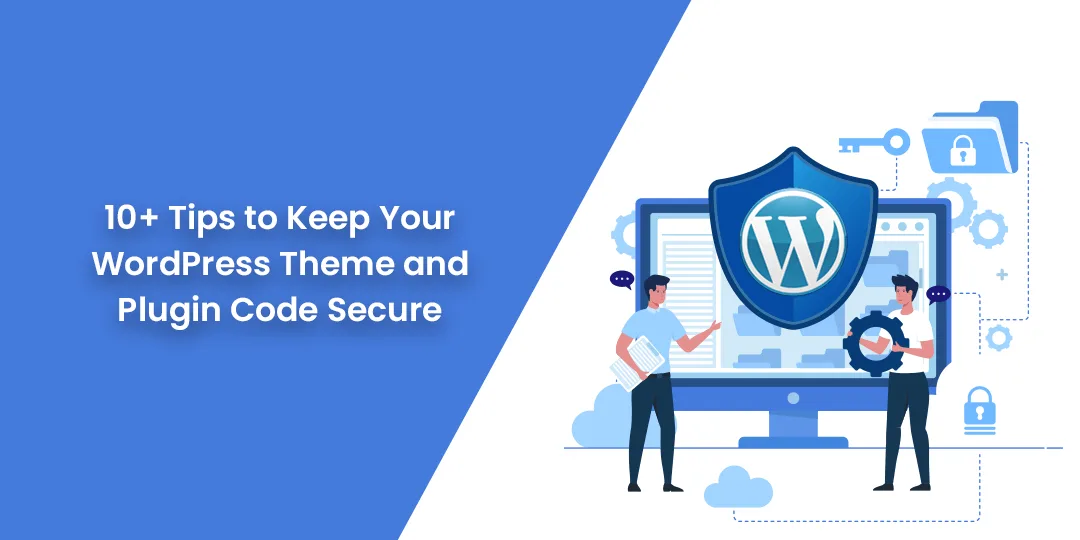The cyber-world sounds interesting from the outside. But not to forget, it can be dangerous too. Even if everything seems proper to you, you would never know when a cyber-attack hits your ground.
In case you have a WordPress website, you know that maintaining the site well-protected against hackers requires considerable effort. For instance, hackers are continually trying to break into different sites using brute force attacks, phishing, malware, and other techniques.
Hackers continue to find new methods to breach security measures, even after plugin and theme code bugs are fixed routinely.
Hire a dedicated WordPress Developer who can do all your WordPress activities seamlessly.
To prevent the crisis from getting more harmful, it is necessary to do all you can.
So, here are some tips and tricks that will help you secure your WordPress themes and plugins.
10+ Tips to Keep Your WordPress Theme and Plugin Code Secure
#1 Choose Themes & Plugins Smartly
WordPress developers need to regularly update the plugins and themes just like apps. If the plugins and themes are not kept up to date, there are chances of bugs and threats.
There are developers that regularly bring about new versions and updates to remove bugs.
Accordingly, your themes and plugins will not only stay protected but you can also advance your features, enhance design layouts, speed-up loading, and so much more.
Get to know the Best WordPress Plugins
#2 Validate Entered Data
The contact forms in a website can be a reason for threats to enter and damage your site. If your website consists of forms that take some kind of user input, be very cautious. Validate the forms in such a way that they should not accept any kind of malicious input.
Even though WordPress includes a built-in feature of data validation, you may have to customize the code to get excellent and accurate outcomes.
Try customizing input columns. Make certain columns mandatory to fill in the form. If only an email id is entered then the form cannot be accepted.
#3 Figure out what data needs protection
Security principle number one in web development is only storing the data you actually need.
While processing a new project, keep a check on the data that needs to be stored and encrypted in the company. Also know that if in any case, the data gets corrupted, how much could it damage the business?
Make sure to encrypt the sensitive data so that it becomes challenging to access.
#4 Uninstall Superfluous Themes & Plugins
It looks very attractive to have a lot of WordPress Themes and Plugins. Having so many options makes it difficult to pick their most adequate features out of the rest, mainly when they are free of charge.
A neophyte would completely agree to this. Superfluous themes and plugins can endanger your site data. Even if they are shut or unused, there is no profit from them.
Hence it is better to uninstall these plugins and themes than to let the hackers wreck your website. The good part is that you will be getting an extra room for something valuable to download.
#5 Disable Theme & Plugin Editor
A website with convenient features will be more likely to be a source of responsibility for you. With advanced features comes more risk. Consequently, the spotlight shifts to the theme editor present in your WordPress dashboard.
Whenever you want to tweak or edit the code, it may appear simpler to do it directly from the dashboard, but it is also a risk, which can damage your website completely. In addition, you have to have a closer inspection if the admin account has more than one sharing.
So, you have to disable your WordPress editor. To perform this, append the subsequent code in the wp-config.php file:
// define (‘DISALLOW_FILE_EDIT’, true);
#6 Utilize WordPress Firewall
The most common source of plugin vulnerability is a zero-day vulnerability, which can make the extension extremely vulnerable to cyber-attacks. Whether or not the extension is updated, nothing will be fixed in the presence of it.
Vulnerabilities can easily be caught by hackers. To get rid of threats WordPress firewall comes to the rescue. This firewall keeps all the fearful threats at a distance.
There are a number of WordPress firewalls. Pick the one that is most relevant to your site. But remember the primary goal should be to keep the security intact.
#7 No Access to Plugin Directory
The most beneficial thing to secure your website can be to disconnect the plugin directory. If there are many users take into consideration that this segment is not shared with anyone.
Hackers can easily access your plugins if the plugin directory is open. To do that, obey the underneath steps:
- Create a blank indext.html
- Upload to the plugin directory
- Navigate to the root folder
- Open .htaccess file
- Add Options – Indexes at the start
Choose this technique to ensure that no other person is eavesdropping on your website data.
#8 Be Watchful with User Roles
You would need to be cautious if your WordPress site has more than one user. Originally, it is vital to be certain that the assigned individuals are reliable.
Also, follow the actions performed on the website when these users try to log in. Take help from plugins that will help you track these activities such as Magento 2 Admin Actions Log.
#9 Disable PHP Error Report
You should also disable the PHP error on your website so your themes and plugins remain protected. Due to the fact that this feature notifies you whenever there is an issue on your platform, it can be a great way for hackers to break into your platform.
The PHP error reporting consists of server path data so if the hackers catch up with this error then you will have a tough time thriving your site. So to disable PHP error reporting perform the below simple steps:
- Go to wp-config.php file
- Copy the beneath code to the file-
error_reporting(0); @ini_set(display_errors’,0)
#10 Obtain Themes & Plugins from A Trustworthy Authority
The WordPress domain can ruin everything if you are a newbie. Themes and plugins should be carefully chosen, as well, throughout the process.
Even though free themes and plugins may seem like a good alternative to paid options, there are some that may not be of high quality. They can harm your website. Thus, ensure you are only using dependable sources, such as WordPress community or plugin/theme store. This will aid you in better sustaining your site.
#11 Collaborate with your team
Observe all the security tickets brought up to your support team. If the clients face security issues, remedy the situation as soon as possible. The end-users give the best feedback on your work so utilize it well!
Have a proper discussion with your development team before any new patch release and ensure no strings remain attached.
Wrap Up!
It’s no surprise that plenty of sites get hacked every day. Therefore, your WordPress website must be secured with a significant security package. Your themes and plugins must also be safe in order to do so.
The above are some of the handful of tips to Maintain Your WordPress Themes and Plugins Code. Test it out and prevent cyberpunks from ruining your site.





